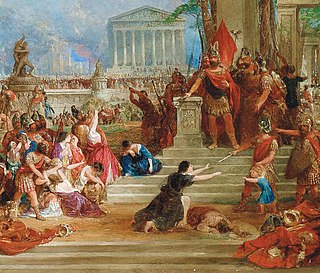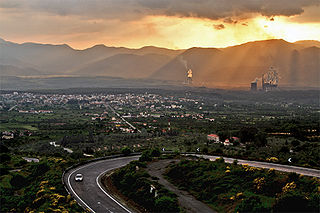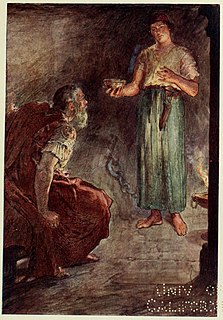Margos (Ancient Greek : Μάργος) of Keryneia (died 229 BC) was the first unique strategos (elected general) of the Achaean League in Ancient Greece. He served during a long period, although only one term is certain in the year 256–255 BC.
Margos started his career around 275 BC by killing the tyrant of Bura and forcing the tyrant Iseas of Keryneia to resign. After joining the Achaean League, he became the leading statesman of the Achaeans and in 256 BC put through a reform to reduce the number of generals from two to one. Margos was then the first leader elected to the post. As elder statesman he later served as navarch (admiral) of the Achaean fleet and fell in the Battle of Paxos against the Illyrians in 229 BC. [1]

The 3rd century BC started the first day of 300 BC and ended the last day of 201 BC. It is considered part of the Classical era, epoch, or historical period.
This article concerns the period 229 BC – 220 BC.
This article concerns the period 259 BC – 250 BC.
This article concerns the period 189 BC – 180 BC.
This article concerns the period 199 BC – 190 BC.
Year 229 BC was a year of the pre-Julian Roman calendar. At the time it was known as the Year of the Consulship of Albinus and Centumalus. The denomination 229 BC for this year has been used since the early medieval period, when the Anno Domini calendar era became the prevalent method in Europe for naming years.

Ancient Greece was a civilization belonging to a period of Greek history from the Greek Dark Ages of the 12th–9th centuries BC to the end of antiquity. This era was immediately followed by the Early Middle Ages and the Byzantine period. Roughly three centuries after the Late Bronze Age collapse of Mycenaean Greece, Greek urban poleis began to form in the 8th century BC, ushering in the Archaic period and colonization of the Mediterranean Basin. This was followed by the age of Classical Greece, from the Greco-Persian Wars to the 5th to 4th centuries BC. The conquests of Alexander the Great of Macedon spread Hellenistic civilization from the western Mediterranean to Central Asia. The Hellenistic period ended with the conquest of the eastern Mediterranean world by the Roman Republic, and the annexation of the Roman province of Macedonia in Roman Greece, and later the province of Achaea during the Roman Empire.

Sicyon or Sikyon was an ancient Greek city state situated in the northern Peloponnesus between Corinth and Achaea on the territory of the present-day regional unit of Corinthia. An ancient monarchy at the times of the Trojan War, the city was ruled by a number of tyrants during the Archaic and Classical period and became a democracy in the 3rd century BC. Sicyon was celebrated for its contributions to ancient Greek art, producing many famous painters and sculptors. In Hellenistic times it was also the home of Aratus of Sicyon, the leader of the Achaean League.

Lucius Mummius, was a Roman statesman and general. Mummius was the first of his family to rise to the rank of consul, making him a novus homo. He received the agnomen Achaicus for his victories while consul in 146 BC, when he conquered the Achaean League and destroyed the ancient city of Corinth following the Battle of Corinth, in the process bringing all of Greece under Roman control.

Megalopoli is a town in the southwestern part of the regional unit of Arcadia, southern Greece. It is located in the same site as ancient Megalopolis. When it was founded in 371 BC, it was the first large urbanization in rustic Arcadia. Its theater had a capacity of 20,000 visitors, making it one of the largest ancient Greek theaters.

The Achaean League was a Hellenistic-era confederation of Greek city states on the northern and central Peloponnese. The league was named after the region of Achaea in the northwestern Peloponnese, which formed its original core. The first league was formed in the fifth century BC. The second Achaean League was established in 280 BC. As a rival of Antigonid Macedon and an ally of Rome, the league played a major role in the expansion of the Roman Republic into Greece. This process eventually led to the League's conquest and dissolution by the Romans in 146 BC.

Philopoemen was a skilled Greek general and statesman, who was Achaean strategos on eight occasions.

Aratus of Sicyon was a politician and military commander of Hellenistic Greece. He was elected strategos of the Achaean League 17 times, leading the League through numerous military campaigns including the Cleomenean War and the Social War.

Arcadia is a region in the central Peloponnese. It takes its name from the mythological character Arcas, and in Greek mythology it was the home of the god Pan. In European Renaissance arts, Arcadia was celebrated as an unspoiled, harmonious wilderness; as such, it was referenced in popular culture.
Lydiadas of Megalopolis was an ancient Greek tyrant of his city Megalopolis in Arcadia. He came to power around the year 245 BC, but after ten years he decided to step down, leading his city to join the Achaean League. As a reward the Achaeans elected him to the post of strategos, that is of the League, for three terms in 234/33, 232/31 and 230/29 BC. In 227 BC he lost the elections against Aratus of Sicyon, but was chosen as hipparch, in this position he fell at the gates of his city during a cavalry charge against the Spartan king Cleomenes III.
Aristomachos of Argos was a general of the Achaean League in Ancient Greece who served only for a year, 228 – 227 BC. His father Aristomachos the Elder and his brother Aristippos had both been tyrants of the city of Argos, and after the latter's death in 235 the younger brother became tyrant himself. In 229 he was convinced to resign by Aratus of Sicyon and let his city join the Achaean League. As a reward, he was elected strategos of the League. Later he betrayed Argos to Cleomenes of Sparta. When Argos was retaken by the forces of Achaea and Macedonia, he was tortured and executed, probably in 223 BC.

Keryneia is a village and a community in the municipal unit of Diakopto, Achaea, Greece. The community consists of the villages Keryneia and Nea Keryneia. It is located 6 km southeast of Aigio and 7 km west of Diakopto. The Greek National Road 8A passes between Keryneia and Nea Keryneia. In 2011 Keryneia had a population of 35 for the village and 362 for the community. The town takes its name from the ancient town of Ceryneia

Korkyra was an ancient Greek city on the island of Corfu in the Ionian sea, adjacent to Epirus. It was a colony of Corinth, founded in the archaic period. According to Thucydides, the earliest recorded naval battle took place between Korkyra and Corinth, roughly 260 years before he was writing — and thus in the middle of the seventh century BC. He also writes that Korkyra was one of the three great naval powers in fifth century BC Greece, along with Athens and Corinth.

The Battle of Paxos was a naval battle between a coalition of Illyrian federation with their Acarnanian allies, against the allies of Corcyra, the Achaean League and Aetolian League. The battle took place in the spring of 229 BC and was a direct consequence to the siege of Corcyra by the forces of queen Teuta.
Ceryneia or Keryneia (Ancient Greek: Κερύνεια, also Cerynia or Kerynia, Ceraunia or Keraunia, Cerauneia or Kerauneia, Caryneia or Karyneia, was a town and polis of ancient Achaea. It was not originally one of the 12 Achaean cities, though it afterwards became so, succeeding to the place of Aegae. Its population was increased by a large body of Mycenaeans, when the latter abandoned their city to the Argives in 468 BCE. Ceryneia is mentioned as a member of the Achaean League on its revival in c. 280 BCE; and one of its citizens, Marcus, was chosen in 255 BCE as the first sole General of the League. In the time of Strabo, Ceryneia was dependent upon Aegium. It was situated inland upon a lofty height, west of the river Cerynites, and a little south of Helice. Theophrastus stated that the wine of Ceryneia produced abortion.